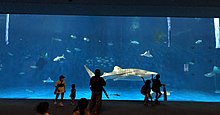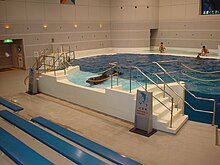Kagoshima Aquarium
History
Opened on May 30, 1997. The Kagoshima coast, which is washed by Kuroshio, and Kagoshima Bay marine life are mainly exhibited, but brackish water and river life are also handled. The specialties are whale shark (Yuyu) and Satsumahaorimushi. The Japanese name "Io" is Kagoshima dialect and means fish. Total project cost is about 12.7 billion yen. The appearance is an image of Stingray. Kagoshima Aquarium is the first aquarium in Japan to successfully feed Chinese sturgeon and display under salt water. In October 2011, the number of visitors reached 10 million. At the end of the route, the "Sea of Silence", which was conceived by the first director, Hiromasa Yoshida, is displayed along with the text. The creatures are not exhibited inside and are filled only with water, but it is said that this is to make people think about the marine environment.
Exhibits




The hall is from the 5th floor to the 2nd basement floor, and you can walk along the route to see it.
- Kuroshio Sea "Kuroshio Large Aquarium" - Whale Shark, Rhina ancylostoma, Spotted Eagle Ray, Chinese Sturgeon, Bluefin Tuna, Katsuo, Milkfish, etc.
- Nansei Islands Sea-Giant Grouper, Damselfish, Butterflyfish, Heteroconger hassi, Coral, Comatulida Kind etc.
- Sea of Kagoshima-Spider crab, Moray eel, Spiny lobster, Flounder, Banded coral shrimp, Sardine, Bullhead shark, etc.
- Observation Hall-Tropical Bottlenose Whale Whole body skeleton specimen. You can see Sakurajima on the opposite bank in front of you.
- Satsumahaorimushi corner
- Seaweed and fish-Aquarium that reproduces the coastal Kelp forest. Pandaka etc.
- Freshwater aquarium-Vallisneria asiatica, Oryzias, Caridina multidentata, Freshwater shrimp, etc.
- Life of jellyfish-Moon jellyfish, Spotted jellyfish, etc.
- Theater room
- Giant mottled eel Aquarium-Giant mottled eel, Flagtail
- cafeteria
- Giant mottled eel Aquarium / Arapaima Aquarium
- Mangrove Aquarium-Terapon jarbua, Mudskipper, etc.
- Seal Aquarium-Spotted Seal
- Dolphin pool-Bottlenose dolphin
- Amusement shop
- Touch pool-starfish, sea cucumber
- Outdoor waterway -Ocean Sunfish, Mahi-mahietc.
Whale shark "Yuyu"
The Kagoshima Aquarium has a large Kuroshio tank with a water volume of 1,500,000 litres (396,000 US gal), but it is not large enough to captivity whale sharks that easily exceed 10 m (33 ft) when grown. Therefore, the Kagoshima Aquarium is exhibited and captivity by the "Kagoshima method", in which training is conducted to return to the wild before the body length reaches 5.8 m (19 ft), and then returned to the wild. A transmitter is attached to the whale shark that returns to the sea, and it has been successful in grasping the migration route of the whale shark.。
The whale sharks raised in the Kuroshio Tank have been called "Yuyu" for generations and are gaining popularity among visitors.
- First generation (male)
- October 20, 2000 Kagoshima Prefecture Takayama Town (currently Kimotsuki Town) Set Net. Body length 4.25 m (13.9 ft).
- November 22, 2000: Exhibition captivity started in the Kuroshio tank.
- July 24, 2002 Moved from the Kuroshio Tank to a marine cage in Kagoshima Prefecture Kasasa Town (currently Minamisatsuma City). A little over 5 m (16 ft) in length.
- Released on August 1, 2002.
- Second generation (male)
- June 17, 2002 Captured with a fixed net in Kagoshima Prefecture Kasasa Towm (currently Minamisatsuma City). Body length 3.8 m (12 ft).
- July 24, 2002 Started captivity on display at the Kuroshio Tank.
- July 28, 2005 Moved from the Kuroshio Tank to the marine cage in Kasasa Town, Kagoshima Prefecture. Body length over 5.4 m (18 ft).
- Released off the coast of Cape Noma, Kasasa-cho on August 8, 2005.
- Third generation (female)
- June 25, 2005 Kagoshima Prefecture Bonotsucho Akime Captured with a set net off the coast. Body length 4.4 m (14 ft).
- July 28, 2005 Started exhibiting and captivity in the Kuroshio Tank.
- July 21, 2007 Moved from the Large Kuroshio Tank to a marine cage in Minamisatsuma City, Kagoshima Prefecture. Body length less than 5.3 m (17 ft).
- Released off the coast of Kasasa, Minamisatsuma City on July 31, 2007.
- 4th generation (male)
- July 20, 2005 Captured with a set net in Kasasa Town, Kagoshima Prefecture. Body length 1.36 m (4.5 ft), weight 15.2 kg.
- July 21, 2005 Delivered to Kagoshima Aquarium.
- October 27, 2005 Exhibited and captivity under the nickname "Yuta" in the underwater tunnel part of the Kuroshio Tank, separated from other exhibited creatures.
- July 21, 2007 Started exhibiting as the 4th generation Yuyu. Body length 2.58 m (8.5 ft).
- August 4, 2009 Moved from the Kuroshio Tank to the marine cage in Minamisatsuma City, Kagoshima Prefecture. Body length 4.47 m (14.7 ft).
- August 5, 2009 Found dead in a marine cage in Minamisatsuma City, Kagoshima Prefecture.
- Fifth generation (male)
- June 25, 2009 Captured with a fixed net in Kasasa-cho, Minamisatsuma City, Kagoshima Prefecture. Body length 3.8 m (12 ft).
- August 4, 2009: Exhibition breeding started in the Kuroshio tank.
- August 23, 2011 Moved from the Kuroshio Tank to the marine cage in Minamisatsuma City, Kagoshima Prefecture. Body length 5.1 m (17 ft).
- Released off the coast of Noma Cape, Minamisatsuma City on September 7, 2011. (Equipped with satellite transmitter)
- 6th generation (male)
- July 15, 2011 Captured with a set net of the Kaiei Fisheries Cooperative in Ibusuki City. Body length 3.7 m (12 ft).
- August 23, 2011: Exhibition captivity started in the Kuroshio tank.
- November 4, 2014 Moved from the Kuroshio Tank to a marine cage off the coast of Kataura Port, Kasasa-cho, Minamisatsuma City, Kagoshima Prefecture.
- November 9, 2014: Physical condition suddenly changed and death was confirmed.
- 7th generation (male)
- August 3, 2015 Captured with a set net of the Takayama Fisheries Cooperative in Kimotsuki Town. Body length 4 m (13 ft).
- August 23, 2015: Exhibition captivity started in the Kuroshio tank.
It was planned to be exhibited as a highlight from the beginning of the museum in 1997, but it died in March and May of the same year, and it has a history of opening without a whale shark.
Tropical Bottlenose Whale

A whole-body skeleton specimen of the tropical bottlenose whale Indopacetus pacificus is displayed in the observation hall on the 5th floor. Tropical bottlenose whales are extremely rare whales, and it is rare to observe whole-body skeleton specimens.
This skeleton specimen is a specimen of an individualNational Museum of Nature and Science, Kagoshima Aquarium, and University of Auckland that was washed ashore in Kagoshima Prefecture Satsumasendai City on July 26, 2002.
Sanderia malayensis
The jellyfish corridor opened in March 2017, and is exhibiting the world's first deep-sea inhabited Sanderia malayensis.
Rhynchobatus mononoke

In 2020, research by research groups such as Kuroshio Biological Research Institute revealed that the ray that had been bred for 23 years as Rhynchobatus djiddensis since its opening was a new species called Rhynchobatus mononoke. The discovery of a new species of ray in the waters near Japan is said to be the first in about 10 years.
Gallery
Exterior
Aquarium
Dolphin pool
References
- ^ 宮沢浩. イラストで読む建築 日本の水族館53次. 青幻舎.
- ^ JAZA. "正会員名簿【水族館】" (in Japanese). Retrieved 2024-02-27.
- ^ かごしま水族館条例の施行期日を定める規則(平成9年4月2日 規則第68号) - 鹿児島市例規集
- ^ 「イルカの水しぶきに歓声 かごしま水族館、花火でオープン」『朝日新聞』1997年5月31日、鹿児島版。
- ^ 「かごしま水族館の愛称 「いおワールドに」恒吉さんが命名」『朝日新聞』1997年2月26日、鹿児島版。
- ^ 奥村『水族館狂時代』、62-66頁
- ^ "入館者1000万人達成=鹿児島市営水族館". 時事通信社. 2017-10-11. Retrieved 2017-11-02.
- ^ 何もない水槽「沈黙の海」 亡き水族館長の思いに「涙でた」「鳥肌」
- ^ 2011年9月4日死亡http://www.ioworld.jp/various/images/newsletter56.pdf さくらじまの海56号 2011年第15巻第3号
- ^ かごしま水族館「ゴマフアザラシの一般公開がはじまりました」
- ^ かごしま水族館 「ジンベエザメの遊泳経路調査」
- ^ 奥村『水族館狂時代』、63頁
- ^ 南日本新聞 「ジンベエザメ、世代交代 かごしま水族館」 2007年7月22日(2007年8月13日アクセス)
- ^ 読売新聞 「ジンベエザメの6代目「ユウユウ」かごしま水族館に」2011年8月24日(2011年10月9日アクセス)
- ^ 国立科学博物館、かごしま水族館、オークランド大学 「2002年7月26日鹿児島県川内市内に漂着したクジラについて」
- ^ 資料提供:川内市、展示総監修:国立科学博物館 山田格、骨格補修展示工事:(株)西尾製作所
- ^ "深海の"アマガサ" 珍クラゲ世界初展示 かごしま水族館". 南日本新聞. 2017-04-18. Retrieved 2017-04-22.
- ^ "1997年から展示のエイは"新種"だった…鹿児島市の水族館". 西日本新聞. 2020-09-26. Retrieved 2020-09-30.
- ^ "23年飼育のエイ、実は新種 三角巾着けた幽霊?鹿児島". 日本経済新聞. 2020-09-28. Retrieved 2020-09-30.
External links
- Official Site (in Japanese)
- Official Site (in English)
















